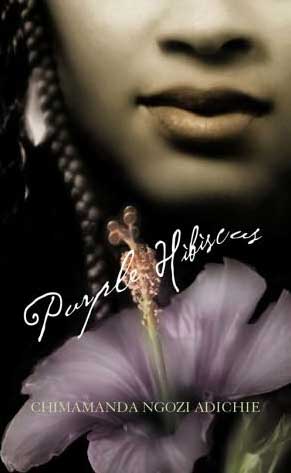BOOK REVIEW: Purple Hibiscus by Chimamanda Ngozi Adichie, fiction, Fourth Estate – Harper Collins, large format paperback, 2004, 307 pages.
se-duc-tive –adjective
tending to seduce; enticing; beguiling; captivating: a seductive smile.
Purple Hibiscus is a seductive book.
Set in Nigeria during a military coup, it charts the development of Kambili, the 15 year old protagonist, from petrified, silent schoolgirl, terrorised by her zealously religious father, to awakening young adult, learning to stand up for herself.
 The catalyst for this change is her Aunty Ifeoma, and the joyful approach she and her three children have towards life. Kambili and her elder brother, Jaja, holiday with their aunt and, during this time, filigrees of change are wrought.
The catalyst for this change is her Aunty Ifeoma, and the joyful approach she and her three children have towards life. Kambili and her elder brother, Jaja, holiday with their aunt and, during this time, filigrees of change are wrought.
You’re starting to undress already, aren’t you? Metaphorically speaking, of course.
Let me explain what I mean when I say Purple Hibiscus is seductive.
When I think about this book, there are a number of elements to it that are identifiably cliched. For instance, there’s the young girl who awakens to an awareness of her self and others; there’s the poor but joyful relation who remains buoyant and optimistic in the face of poverty and political uncertainty; and there’s the oppressive father who terrorises his children but is outwardly perceived as a pillar of the community.
Now, cliches are generally thought to be the last bastion of the unimaginative. And they’re often uninteresting because we’ve seen them so often before. But cliches are double-edged creatures. The reason why they’re cliches and why we’ve seen them so often before is because, quite simply, they work.
What Adichie has done is take a few cliches and make them work for her. They provide structure and plot, and she infuses them with a sometimes joyous, sometimes horrifying, reality. But she also slightly subverts them, which not only showcases the less-than-perfect world we live in but also creates a book strong on complexity, intelligence and real world colour.
For example, if we take a look at the storyline of the young girl awakening to adulthood, Kambili awakens to a reality that’s far from pleasant, involving as it does tragic parental behaviour and, to a lesser extent, the state of Nigeria. It’s not the fairytale arrival which often accompanies coming-of-age stories.
Similarly, in relation to the cliche of the oppressive father, Adichie uses the friction inherently generated by such a character to sustain the writing over many pages. But she chooses to cloud our condemnation of him by ensuring that we see that Kambili loves him even though she also fears him. Kambili’s love shows us that he is a father and has a relationship with his daughter even though it’s an undesirable one. It creates a complex reality that isn’t easily reconciled.
In case I’m making this book sound somewhat bleak and possibly, difficult, I want to point out, it’s not. Not completely, anyway. As the title suggests, ‘purple hibiscus’ is the metaphor that grounds the book. At the very beginning of the novel Kambili says:
Aunty Ifeoma’s little garden next to the verandah of her flat in Nsukka began to lift the silence. Jaja’s defiance seemed to me now like Aunty Ifeoma’s experimental purple hibiscus: rare, fragrant with the undertones of freedom, a different kind of freedom from the one the crowds waving green leaves chanted at Government Square after the coup. A freedom to be, to do.
So purple hibiscus represent freedom and though rare, remain something to seek, something to try and attain. Similarly, Kambili’s attempts at freedom — to be who she wants to be — while rare, remain something to hope for, something to try and attain. Hope is at the core of this novel and it’s hope that we’re left with at its end.
Part of the charm of Purple Hibiscus – an additional reason why you might want to take your clothes off again, metaphorically speaking, of course – is its characters. I’ve already mentioned the honest portrayal of emotions from Kambili towards her father — well, there are additional relationships in this novel which are as complicated.
In fact, one of the things this novel does well is display the relationships that exist or develop between characters, particularly those involving Kambili. There is a sense of real depth in her relationships with her brother, mother, aunt, cousin and then a young, good looking priest whom she meets while staying with her aunt. How is that last relationship resolved? I can only say, read the book.
Opulent characterisation and defiant twisting of cliche, hovering over twin heartbeats of freedom and hope — can you see why I think Purple Hibiscus is seductive?
Purple Hibiscus is Chimamanda Ngozi Adichie’s first novel. Her second novel, Half of a Yellow Sun, won the 2007 Orange Prize for Fiction. Her latest release is a book of short stories entitled The Thing Around Your Neck.
I haven’t got anything much else to add except to say, I really liked this book so I reckon you should go out and read it, nude or otherwise.